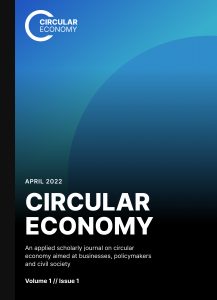Journal of Circular Economy
An applied scholarly journal on circular economy
April 2025
Outline
Systems and Ecosystems in the Circular Economy: What’s the Difference?
Abstract
Keywords
How to cite this article?
Kanda, W. (2023). Systems and Ecosystems in the Circular Economy: What’s the Difference?. Journal of Circular Economy, 1(3). https://doi.org/10.55845/RMDN3752
References
Aarikka-Stenroos, L., Ritala, P., & Thomas, L. D. (2021). Circular economy ecosystems: A typology, definitions, and implications. In S. Teerikangas, T. Onkila, K. Koistinen, & M. Mäkelä (Eds.), Research handbook of sustainability agency (pp. 257 – 273). Cheltenham: Edwards Elgar Publishing.
Bertalanffy, L. von. (1968). General system theory: Foundations, development, applications. G. Braziller, New York.
Geissdoerfer, M., Savaget, P., Bocken, N. M., & Hultink, E. J. (2017). The Circular Economy–A new sustainability paradigm? Journal of Cleaner Production, 143, 757–768.
Gómez, A. M. M., González, F. A., & Bárcena, M. M. (2018). Smart eco-industrial parks: A circular economy implementation based on industrial metabolism. Resources, Conservation and Recycling, 135, 58–69.
Henry, M., Bauwens, T., Hekkert, M., & Kirchherr, J. (2020). A typology of circular start-ups: An Analysis of 128 circular business models. Journal of Cleaner Production, 245, 118528.
Iacovidou, E., Hahladakis, J. N., & Purnell, P. (2021). A systems thinking approach to understanding the challenges of achieving the circular economy. Environmental Science and Pollution Research, 28, 24785–24806.
Jackson, M., Lederwasch, A., & Giurco, D. (2014). Transitions in theory and practice: Managing metals in the circular economy. Resources, 3(3), 516–543.
Jacobides, M. G., Cennamo, C., & Gawer, A. (2024). Externalities and complementarities in platforms and ecosystems: From structural solutions to endogenous failures. Research Policy, 53(1), 104906.
Kanda, W., Geissdoerfer, M., & Hjelm, O. (2021). From circular business models to circular business ecosystems. Business Strategy and the Environment, 30(6), 2814–2829.
Kirchherr, J., Reike, D., & Hekkert, M. (2017). Conceptualizing the circular economy: An analysis of 114 definitions. Resources, Conservation and Recycling, 127, 221–232.
Konietzko, J. (2020). Business innovation towards a circular economy: An ecosystem perspective. A+ BE| Architecture and the Built Environment, 22, 1–204.
Matschewsky, J. (2019). Unintended circularity?—Assessing a product-service system for its potential contribution to a circular economy. Sustainability, 11(10), 2725.
Moore, J. F. (1993). Predators and prey: A new ecology of competition. Harvard Business Review, 71(3), 75–86.
Parida, V., Burström, T., Visnjic, I., & Wincent, J. (2019). Orchestrating industrial ecosystem in circular economy: A two-stage transformation model for large manufacturing companies. Journal of Business Research, 101, 715–725.
Sakao, T., & Lindahl, M. (2009). Introduction to product/service-system design. Springer Science & Business Media, London.
Tansley, A. G. (1935). The use and abuse of vegetational concepts and terms. Ecology, 16(3), 284–307.
Tsvetkova, A., & Gustafsson, M. (2012). Business models for industrial ecosystems: A modular approach. Journal of Cleaner Production, 29, 246–254.
Copyright info
Open Access: This article is licensed under a Creative Commons Attribution 4.0 International License, which permits use, sharing, adaptation, distribution and reproduction in any medium or format, as long as you give appropriate credit to the original author(s) and the source, provide a link to the Creative Commons licence, and indicate if changes were made. The images or other third-party material in this article are included in the article’s Creative Commons licence, unless indicated otherwise in a credit line to the material. If material is not included in the article’s Creative Commons licence and your intended use is not permitted by statutory regulation or exceeds the permitted use, you will need to obtain permission directly from the copyright holder. To view a copy of this licence, visit http://creativecommons.org/licenses/by/4.0/.

